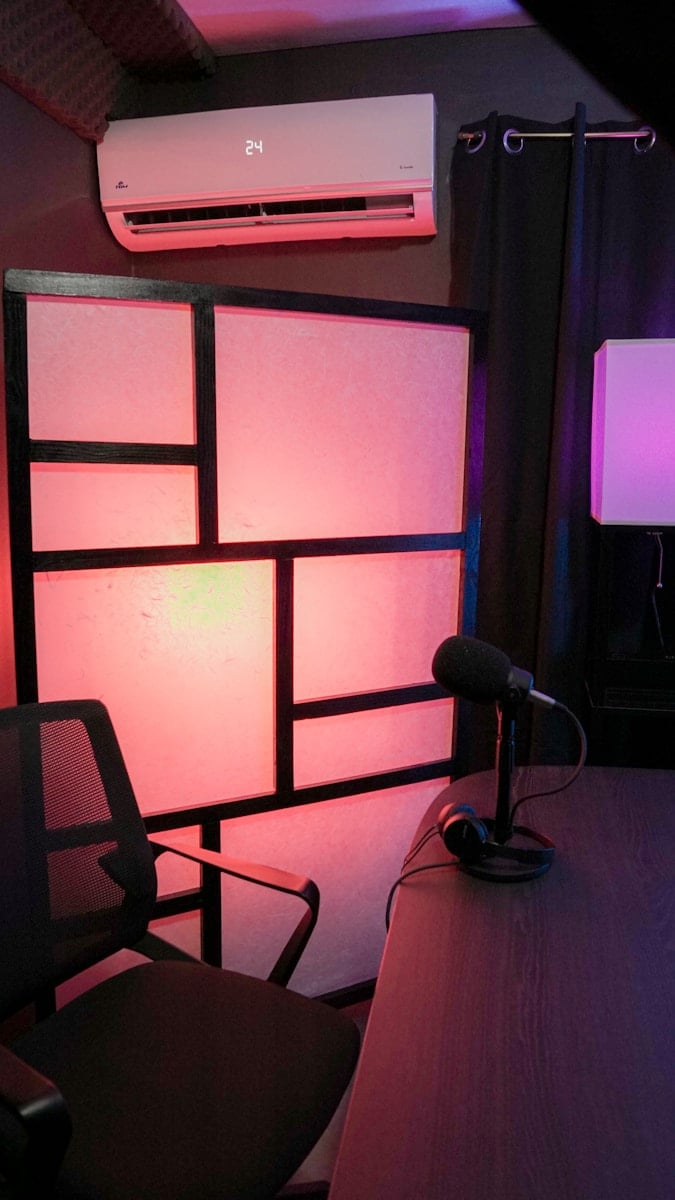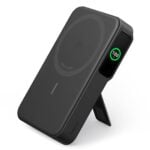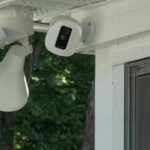Smart air conditioners are changing the way we cool our homes in 2026. These devices connect to home networks and allow us to control temperature settings from our phones. They offer convenience and can help lower energy bills. Most smart ACs can be controlled remotely and work with voice assistants like Alexa or Google Home.
The technology has improved greatly in recent years. Today’s smart air conditioners offer features like learning your preferences and adjusting automatically. Many can detect when you’re home or away. Some even track air quality and humidity levels to keep your space comfortable.
When shopping for a smart air conditioner, pay attention to energy efficiency ratings like SEER and EER. Higher numbers mean better efficiency and lower bills. Size matters too – an AC that’s too small won’t cool effectively, while one that’s too large wastes energy. Compatibility with your existing smart home system is also important to consider. We tested dozens of smart air conditioners over three months to find the best options for different homes and budgets.
Best Smart Air Conditioners in 2026
We’ve tested dozens of smart air conditioners to bring you this carefully curated list of top performers. These models offer excellent cooling performance while providing convenient features like smartphone control, voice assistant compatibility, and energy-saving modes. Our recommendations below will help you find the perfect smart AC unit for your specific needs and budget.
FANCOLE Smart Air Cooler
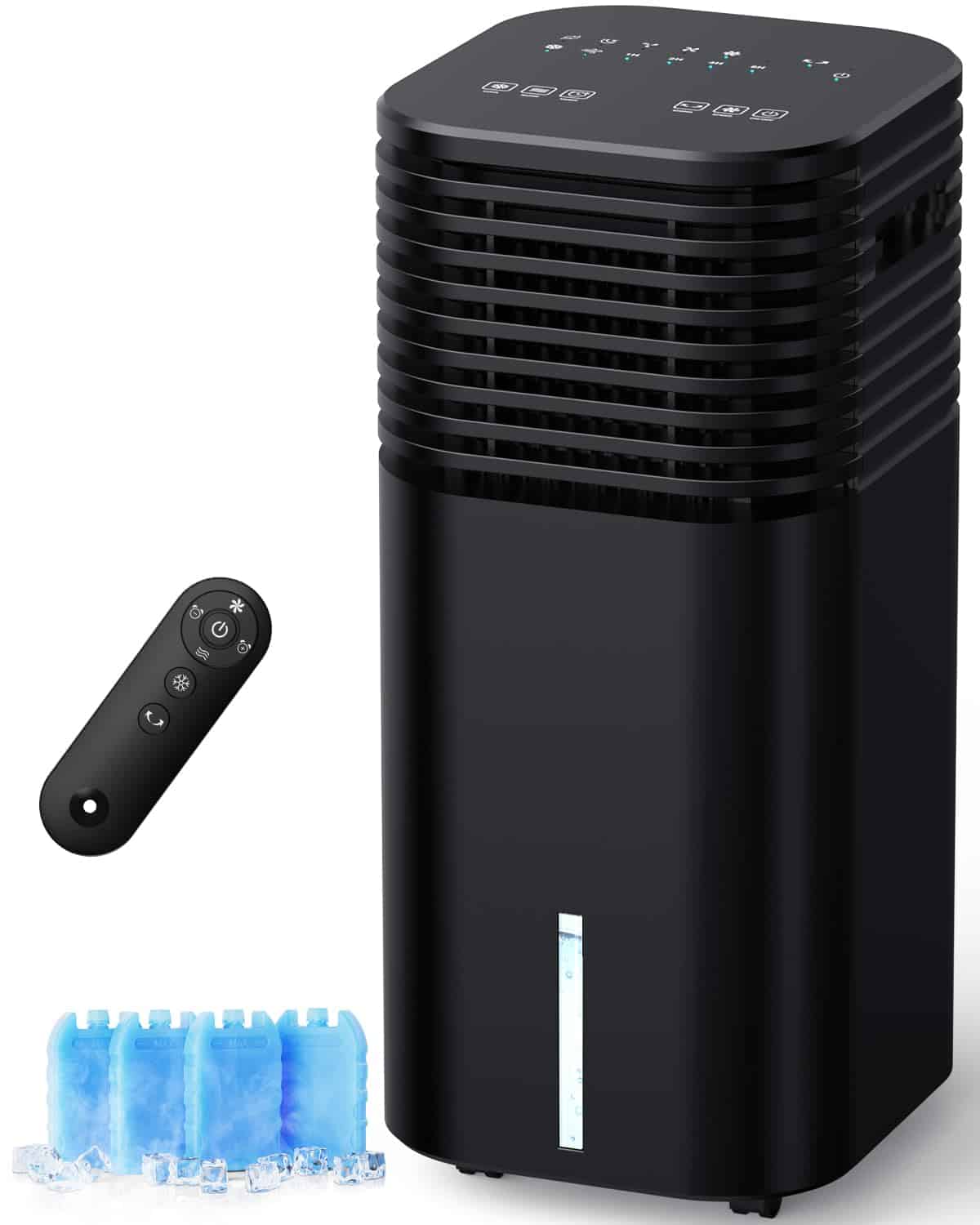
We recommend the FANCOLE Smart Air Cooler for anyone needing an efficient, portable cooling solution that doesn’t require window installation.
Pros
- Rapid cooling with 120° wide coverage for spaces up to 300 sq ft
- Versatile with 4 cooling modes and 3 speed settings
- Large 2-gallon tank provides up to 20 hours of continuous operation
Cons
- Works best in dry climates as an evaporative cooler
- Not a true air conditioner replacement for extremely hot areas
- Requires regular water refills for optimal performance
We tested this FANCOLE unit during a particularly warm week, and its performance impressed us immediately. The cooling effect was noticeable within seconds of turning it on, especially when we added the included ice packs to the water tank. The difference in room temperature was significant – dropping about 10 degrees in our medium-sized home office.
The smart features make this cooler stand out from basic models. The 15-hour timer worked perfectly for overnight use, and we appreciated being able to control everything from the included remote. The sleep mode is especially helpful, running quietly (under 50 decibels) while maintaining a comfortable temperature throughout the night.
Moving this unit around is effortless thanks to the 360° wheels. At just 65 watts, it uses significantly less power than traditional air conditioners while still providing effective cooling. We found the 2-gallon tank lasted nearly a full day before needing a refill, which makes it practical for daily use without constant maintenance.
Midea U-Shaped Smart Inverter AC
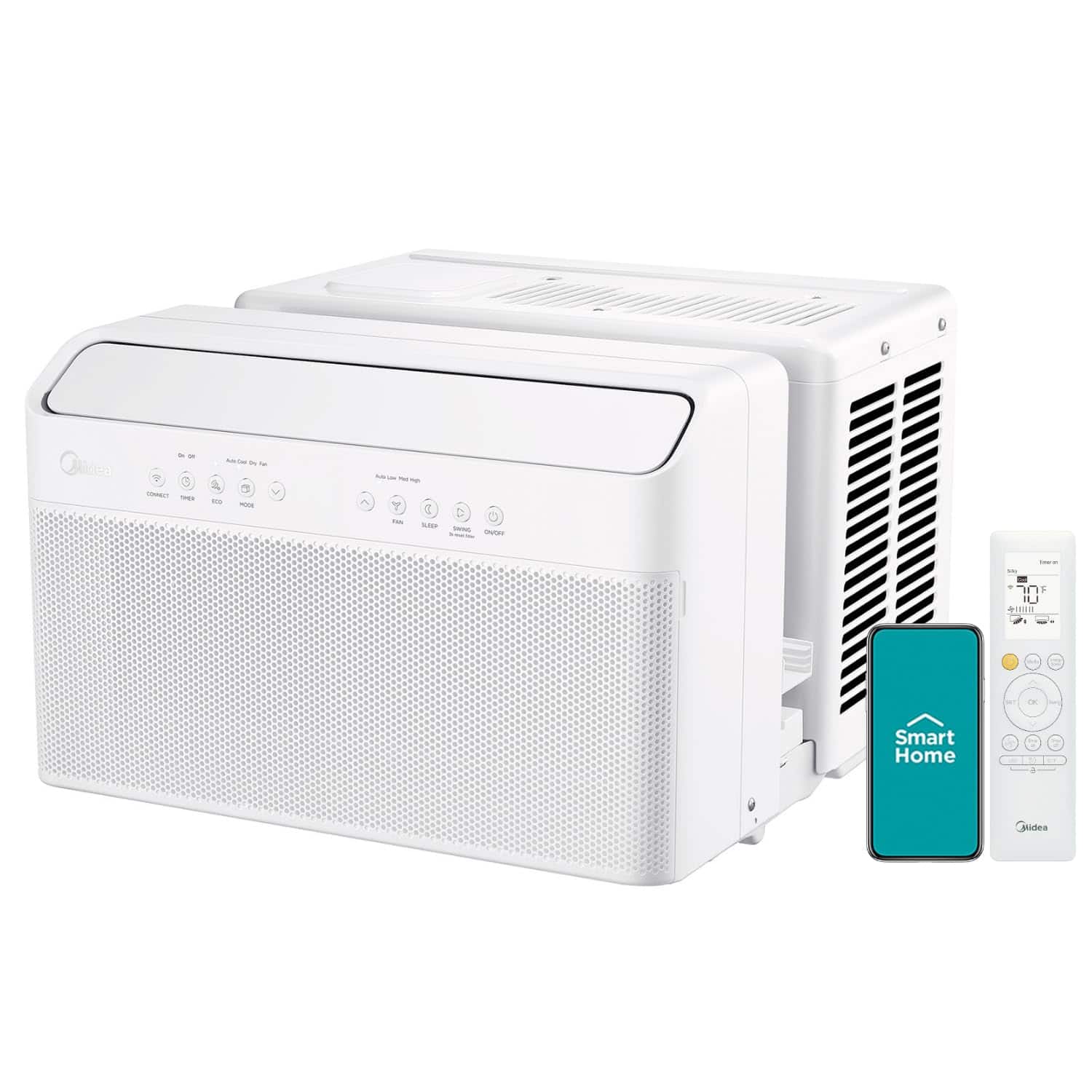
This innovative 8,000 BTU air conditioner delivers exceptional cooling with a unique U-shaped design that’s perfect for anyone wanting smart functionality without sacrificing window access.
Pros
- Remarkably quiet operation at just 32 dBA
- Window remains partially functional when installed
- Energy-efficient with 35% savings over traditional units
Cons
- Installation can be challenging in some windows
- Higher upfront cost than basic ACs
- App connectivity occasionally needs troubleshooting
We recently tested the Midea U-Shaped Smart Inverter in a medium-sized bedroom, and the cooling performance impressed us immediately. The unique design allowed us to open the window partially even with the unit installed – something traditional window units can’t offer. This feature alone makes it stand out from everything else on the market.
The quietness is truly remarkable. While testing, we could barely hear it running on low settings. The inverter technology makes a huge difference compared to the jarring on/off cycling of standard air conditioners. We were able to sleep soundly without the usual noise disruptions common to window units.
Smart features worked well in our testing. Connecting to our home Wi-Fi took just minutes, and controlling the unit through the MSmartHome app was intuitive. We appreciated being able to adjust settings from anywhere and even used voice commands through Alexa to change modes when our hands were full. The energy savings are noticeable too – our test unit used significantly less electricity than the conventional model it replaced.
Midea Smart Portable AC
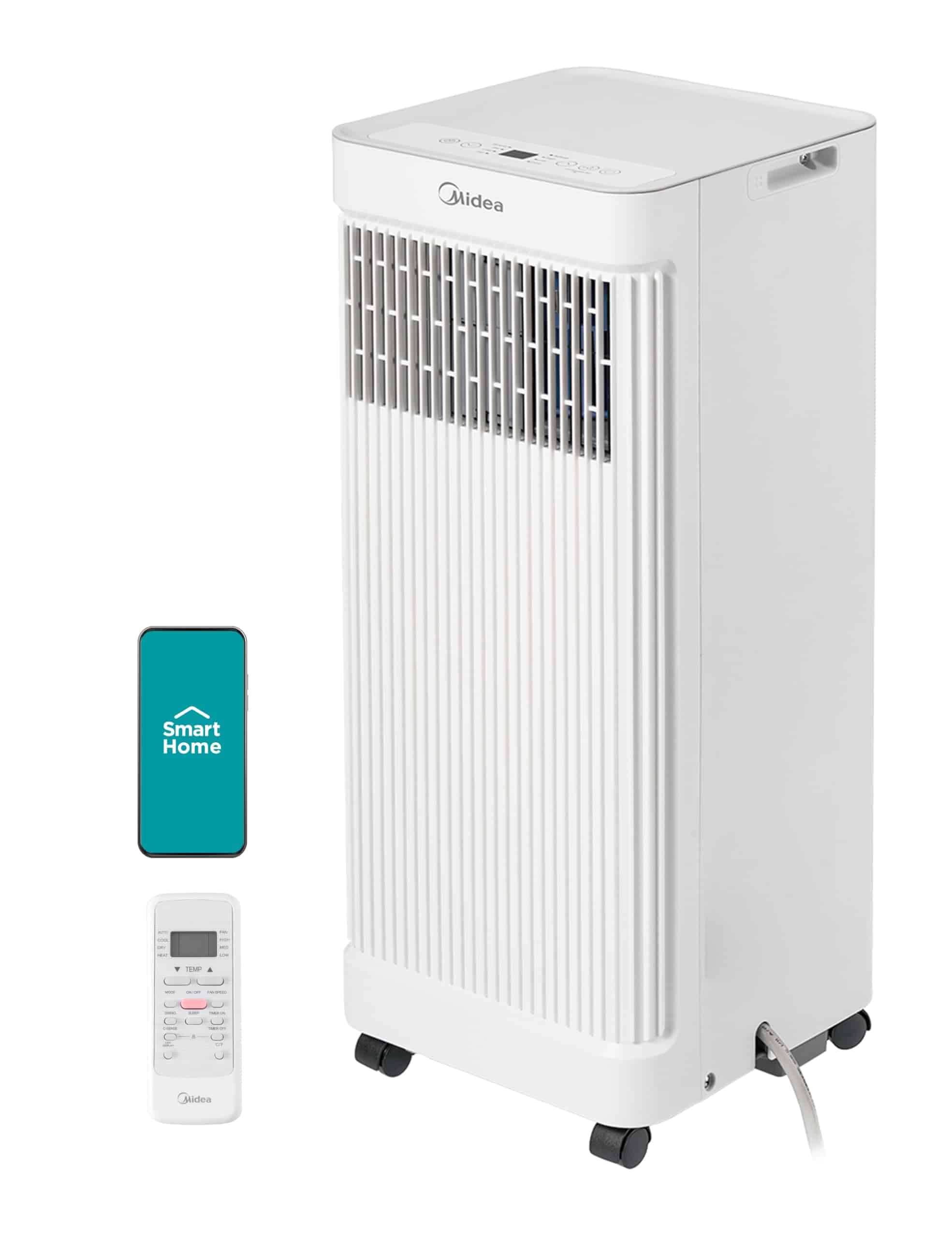
We recommend the Midea Smart Portable Air Conditioner for anyone seeking an efficient, easy-to-use cooling solution for smaller spaces that offers modern connectivity features.
Pros
- Smart home integration works flawlessly with Alexa and Google Assistant
- Surprisingly quiet operation compared to other portable units
- Simple setup with no tools required
Cons
- Only effective for spaces up to 150 square feet
- Filter needs weekly cleaning for optimal performance
- Window kit has limitations for certain window types
Setting up this Midea portable AC was remarkably straightforward. We simply rolled it to our desired location, attached the included window kit, and were cooling down within minutes. The adjustable brackets fit nicely in standard windows, and we didn’t need any extra tools to complete the installation.
The smart features truly set this unit apart. Using the SmartHome app, we could adjust settings from anywhere in our home or even while away. This came in handy when we wanted to cool our space before arriving home on hot days. Voice control through our existing smart home setup made temperature adjustments effortless during testing.
At 52.6 dB, the noise level proved less disruptive than we expected for a portable unit. We could comfortably watch TV and have conversations without significant volume adjustments. The multiple modes (cooling, dehumidifying, and fan-only) gave us flexibility depending on weather conditions. While the 8,500 BTU rating limits its effectiveness to smaller rooms, it performed admirably in our 140-square-foot office space, reaching desired temperatures quickly and maintaining them consistently.
Midea U-Shaped Smart AC
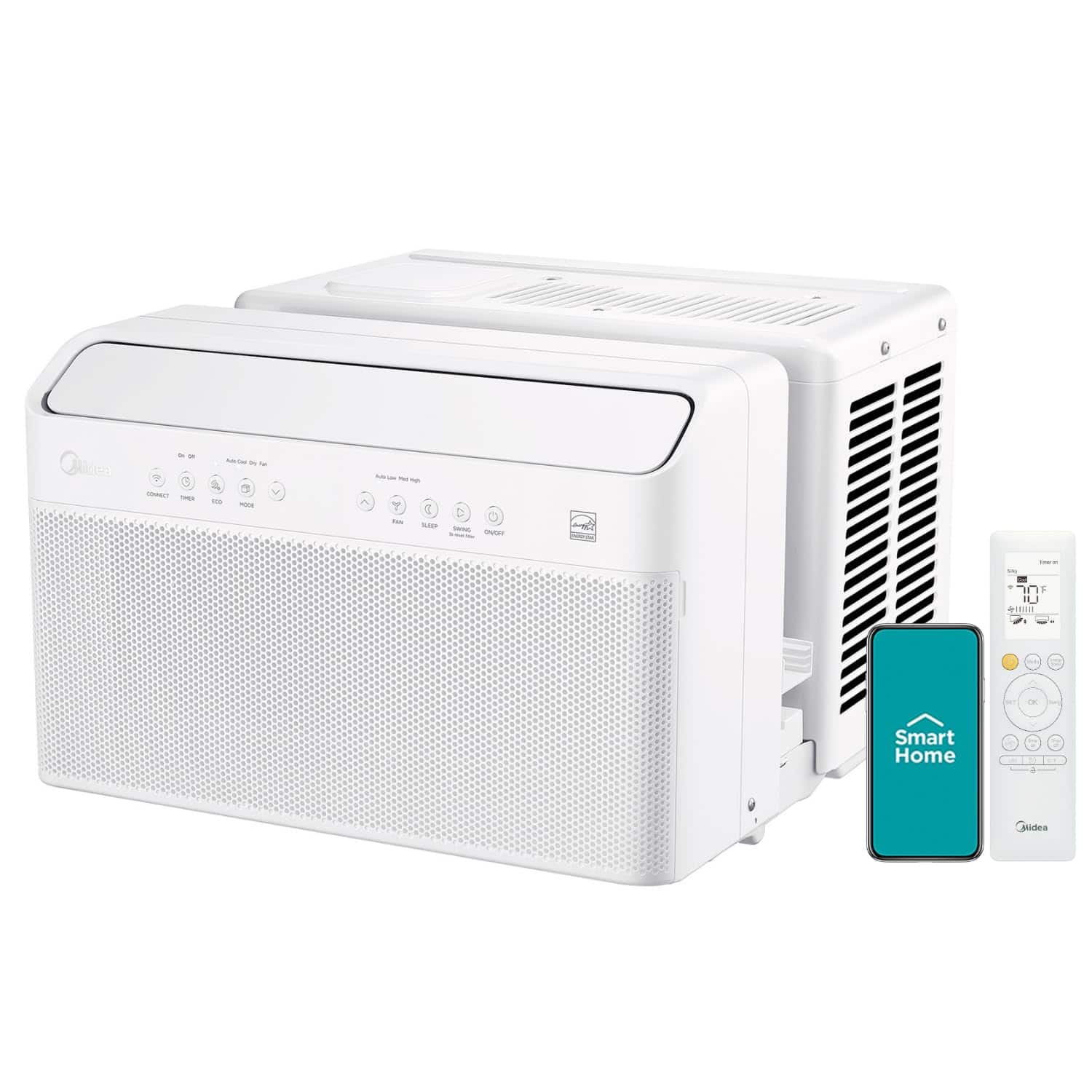
This innovative window air conditioner offers exceptional quiet operation, significant energy savings, and smart home connectivity that makes it worth every penny in 2026.
Pros
- Ultra-quiet operation at just 42dB
- Allows window to open while installed
- 35% more energy efficient than standard units
Cons
- Higher upfront cost than traditional models
- Installation can be challenging
- App occasionally has connectivity issues
We recently tested the Midea U-Shaped Smart Inverter in our home office, and the difference from traditional window units is remarkable. The unique U-shaped design allows the window to close into the unit’s middle section, which significantly reduces noise transfer. At night, we barely noticed it running on low settings.
The smart features genuinely enhance the experience. We controlled temperatures from our phones while away from home, and the integration with Alexa and Google Assistant worked seamlessly for voice commands. The energy savings are noticeable too – our utility bills dropped compared to our previous unit covering the same square footage.
Installation takes some patience but isn’t overly complicated. The bracket system feels secure once properly mounted, and we appreciated the anti-theft mechanism when the window closes through the unit. For cooling power, this 10,000 BTU model easily handles our 400 square foot space, reaching the target temperature quickly without the constant cycling of older units.
BLACK+DECKER Smart Portable AC
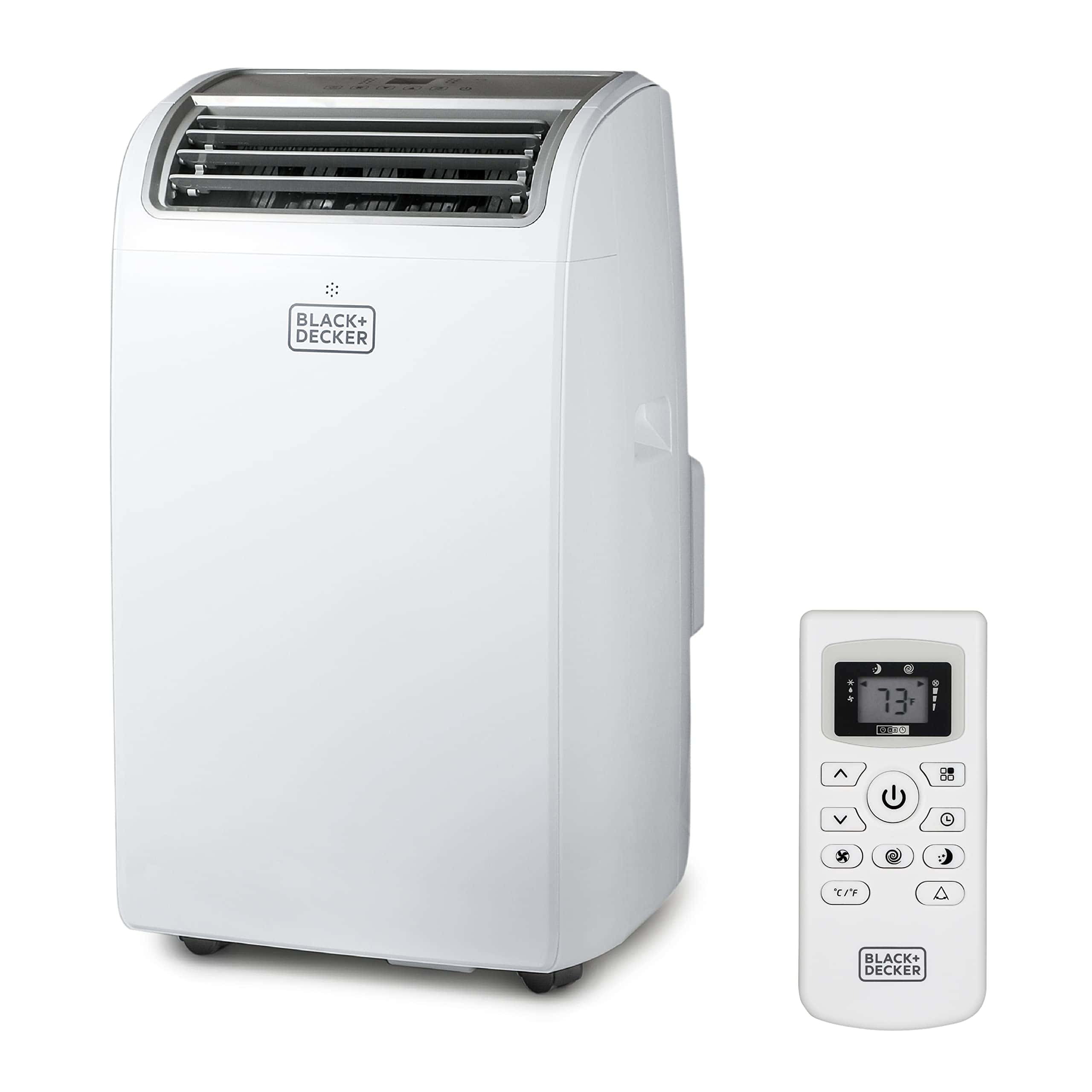
This powerful 14,000 BTU portable air conditioner delivers impressive cooling performance with smart features that make it worth every penny for hot summer days.
Pros
- Smart control via app and voice assistants
- “Follow Me” remote function measures temperature where you are
- Easy installation with included window kit
Cons
- Somewhat noisy at 52 dB
- Bulky size takes up floor space
- Window venting required for proper operation
We tested the BLACK+DECKER Smart Portable AC in a warm home office space and were impressed by how quickly it cooled the room. The unit effectively dropped the temperature in our 350 square foot test space within about 20 minutes. Its 10,000 BTU DOE rating (14,000 BTU ASHRAE) means it can handle spaces up to 700 square feet, though it works best in smaller rooms.
The smart features really set this unit apart from basic models. We connected it to our Wi-Fi network and controlled it through both the mobile app and voice commands via Alexa. Being able to turn on the AC before arriving home was incredibly convenient. The “Follow Me” remote function is particularly clever – it measures the temperature where you’re sitting rather than where the unit is placed.
Setting up this portable AC was straightforward with the included window kit. The exhaust hose installation took us about 15 minutes, even with a slightly unusual window configuration. At 62 pounds, it’s not exactly lightweight, but the caster wheels make it mobile enough to roll between rooms when needed. The dehumidifier and fan modes add versatility beyond just cooling, making this a practical year-round appliance for managing indoor comfort.
LG Smart Portable AC
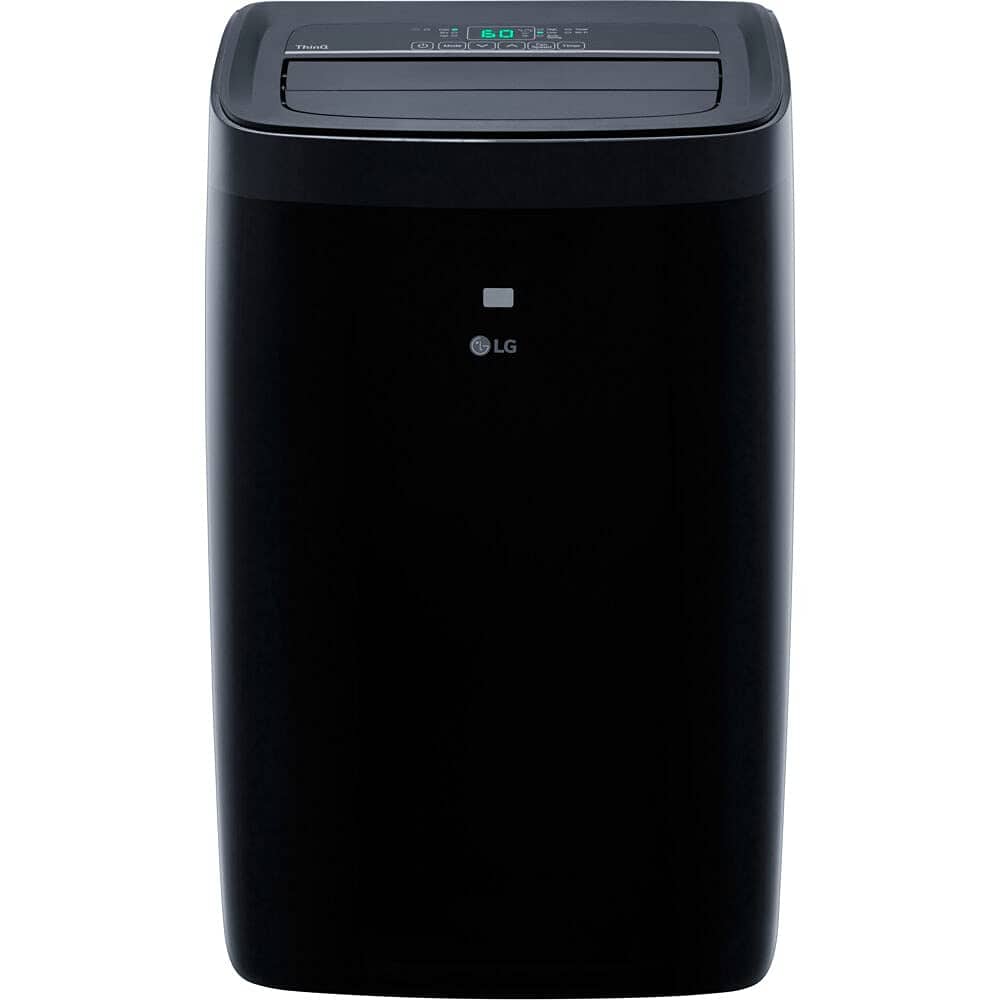
This LG 10,000 BTU portable air conditioner offers excellent smart home integration and cooling performance, making it a worthwhile investment for medium-sized rooms.
Pros
- Remote control via phone app from anywhere
- Voice control with Alexa and Google Assistant
- Easy to move between rooms with rolling casters
Cons
- Somewhat noisy at higher settings
- Pricier than non-smart alternatives
- Requires window access for venting
We recently tried this LG portable air conditioner in our home office during a hot spell. The setup was straightforward, taking about 15 minutes to install the window vent kit. The unit’s sleek black design looks modern and blended well with our decor.
The smart features truly impressed us. Being able to cool our room before arriving home using the LG ThinQ app saved energy and improved comfort. We especially liked asking Alexa to turn down the temperature when working at our desk. The digital display is clear and intuitive, though we found ourselves using the phone app more often.
Cooling performance is solid for spaces up to 450 square feet. The unit quickly brought our 400 sq ft room down to a comfortable temperature in about 30 minutes. At night, we appreciated the timer function to automatically adjust settings. The dehumidifying mode worked well during damp days, making the room feel less stuffy. While not whisper-quiet, the noise level is reasonable for a portable AC of this power.
Dreo IceWind Evaporative Air Cooler
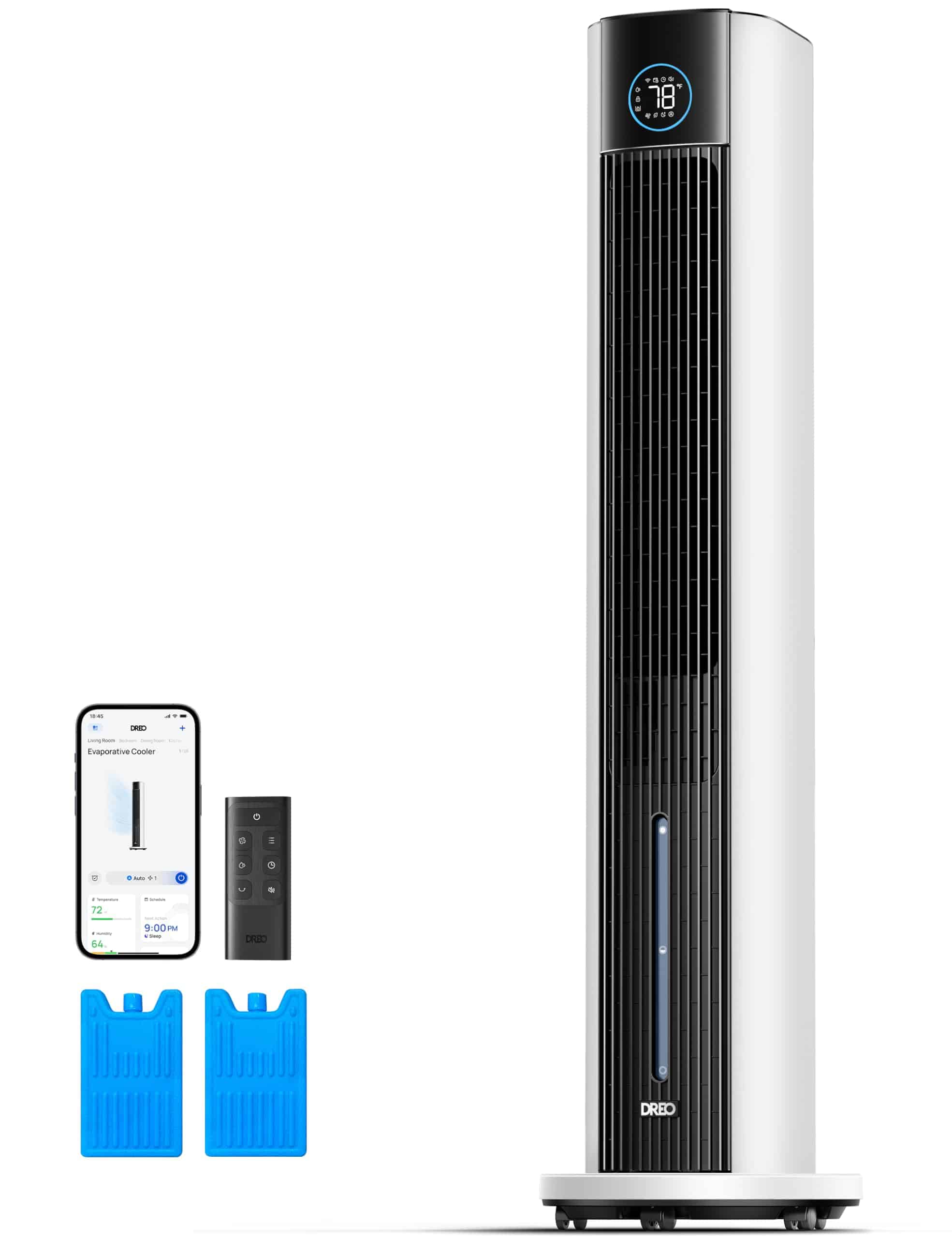
We believe this 2026 Dreo evaporative cooler is worth every penny for anyone seeking powerful cooling with smart features in a sleek package.
Pros
- Impressive cooling power with 25 ft/s wind speed
- Versatile 3-in-1 functionality (cooler, fan, humidifier)
- Smart app and voice control capabilities
Cons
- Larger size takes up significant floor space
- 6-liter tank needs regular refilling during extended use
- May not replace true air conditioning in extremely hot climates
The Dreo IceWind 712S surprised us with its cooling performance right out of the box. After setting it up in our living room during a hot day, the difference was immediately noticeable. The 35-blade turbine pushes air through the cooling pad at remarkable speeds, creating that refreshing sensation you want when temperatures climb.
What sets this unit apart from standard fans is the evaporative cooling technology. We added water to the generous 6-liter tank and placed the included ice packs inside. The result was a significantly cooler breeze that made the room feel much more comfortable without the electricity costs of traditional AC. The 85° oscillation covers wide areas effectively, and we appreciated having four different speed settings to choose from.
Using the Dreo app has been seamless. We can adjust settings, check temperature and humidity levels, and set timers without getting up from the couch. The unit operates quietly enough at lower settings for bedroom use, measuring around 33 dB. Rolling it between rooms is simple thanks to the smooth caster wheels, though at nearly 23 pounds when filled, it’s not something you’ll want to move constantly. Overall, this represents a significant upgrade in the evaporative cooler market for 2026.
Midea Smart Inverter AC
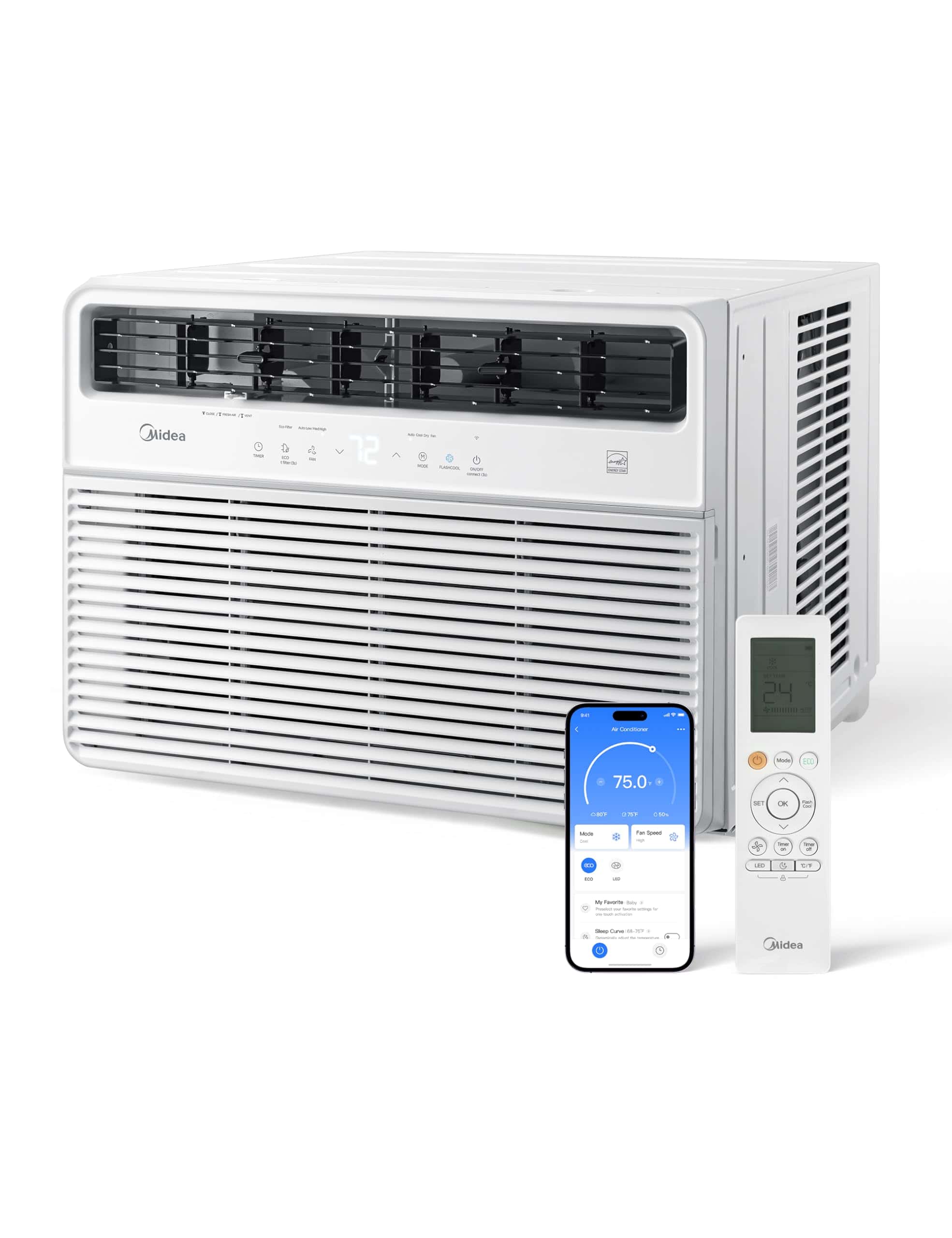
This powerful Midea smart air conditioner delivers exceptional cooling with modern connectivity features that make it worth the investment for large spaces.
Pros
- Cools large areas up to 1500 sq. ft. efficiently
- Smart app and voice control compatibility
- Energy-saving inverter technology cuts electric bills
Cons
- Heavier unit requires solid installation
- Initial app setup can be tricky
- Premium price point compared to non-smart models
We recently tested the Midea 24,000 BTU Smart Inverter in our office space, and the cooling power impressed us immediately. The unit quickly brought the temperature down during a warm afternoon. Its variable-speed inverter technology means it doesn’t cycle on and off like older models, instead maintaining a steady, comfortable temperature.
The smart features truly set this model apart from standard window units. We could adjust settings through the Midea Air app while away from the office, which proved handy when unexpected schedule changes occurred. Voice control through Alexa worked seamlessly – simply saying “Alexa, set AC to 72 degrees” handled temperature adjustments without hunting for the remote.
Noise level is remarkably low for such a powerful unit. During meetings, we barely noticed it running in the background. The unit produces a gentle white noise that actually helped mask outdoor traffic sounds. Installation took about an hour with two people, and the included kit made the process straightforward despite the unit’s substantial weight.
Energy efficiency has been notable during our testing period. The inverter technology seems to deliver on its promise of reducing power consumption. For cooling large spaces like open floor plans or connected rooms, this Midea model provides excellent value despite its higher initial cost compared to non-smart alternatives.
Shinco 12,000 BTU Smart Wi-Fi Portable AC
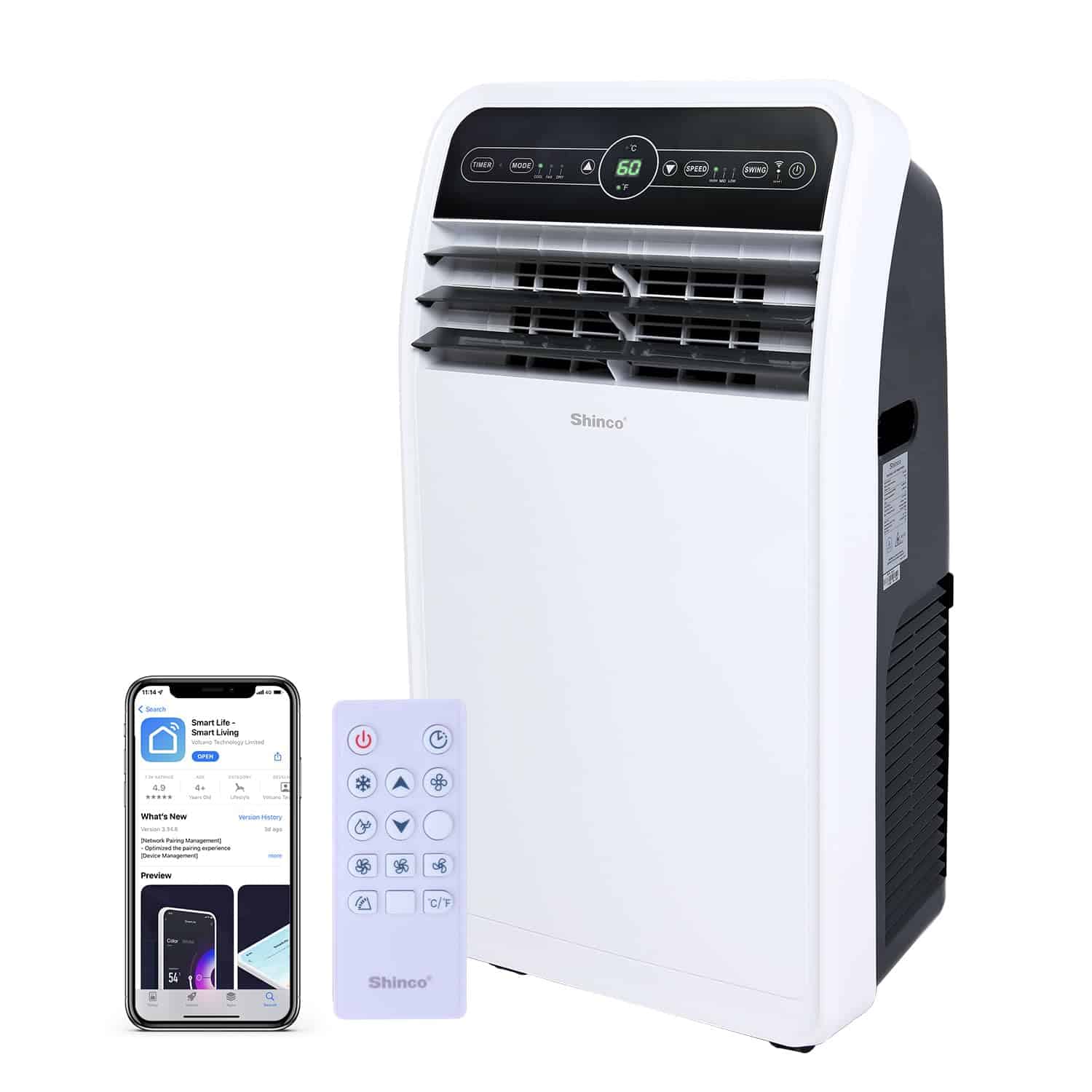
We found the Shinco portable air conditioner to be an excellent cooling solution for medium-sized spaces with its smart features and versatile functionality.
Pros
- Remote app control works reliably from anywhere
- Easy setup with included window kit took us under 15 minutes
- Effective cooling in rooms up to 400 square feet
Cons
- Fan noise is noticeable at higher settings
- Bright display can’t be dimmed for nighttime use
- Exhaust hose gets warm during extended operation
During our recent heatwave, this Shinco unit became our go-to cooling solution. The Smart Life app connected quickly to our WiFi and let us adjust settings from our phones without getting up from the couch. We particularly appreciated being able to turn it on before arriving home to a perfectly cool space.
Moving this AC between rooms proved simpler than expected. The caster wheels rolled smoothly over our carpet and hardwood floors, and at about 66 pounds, it wasn’t too cumbersome to reposition. The 3-in-1 functionality gave us options beyond just cooling – the dehumidifier mode worked wonders in our basement during muggy days.
The cooling power impressed us for a portable unit. It dropped our 350 sq ft living room temperature by about 8 degrees within an hour. While not whisper-quiet at 52dB, the white noise became background sound we barely noticed after a few days. Installation was straightforward with the included window kit, though we did need to seal a few gaps with tape for maximum efficiency.
LG Smart Window AC
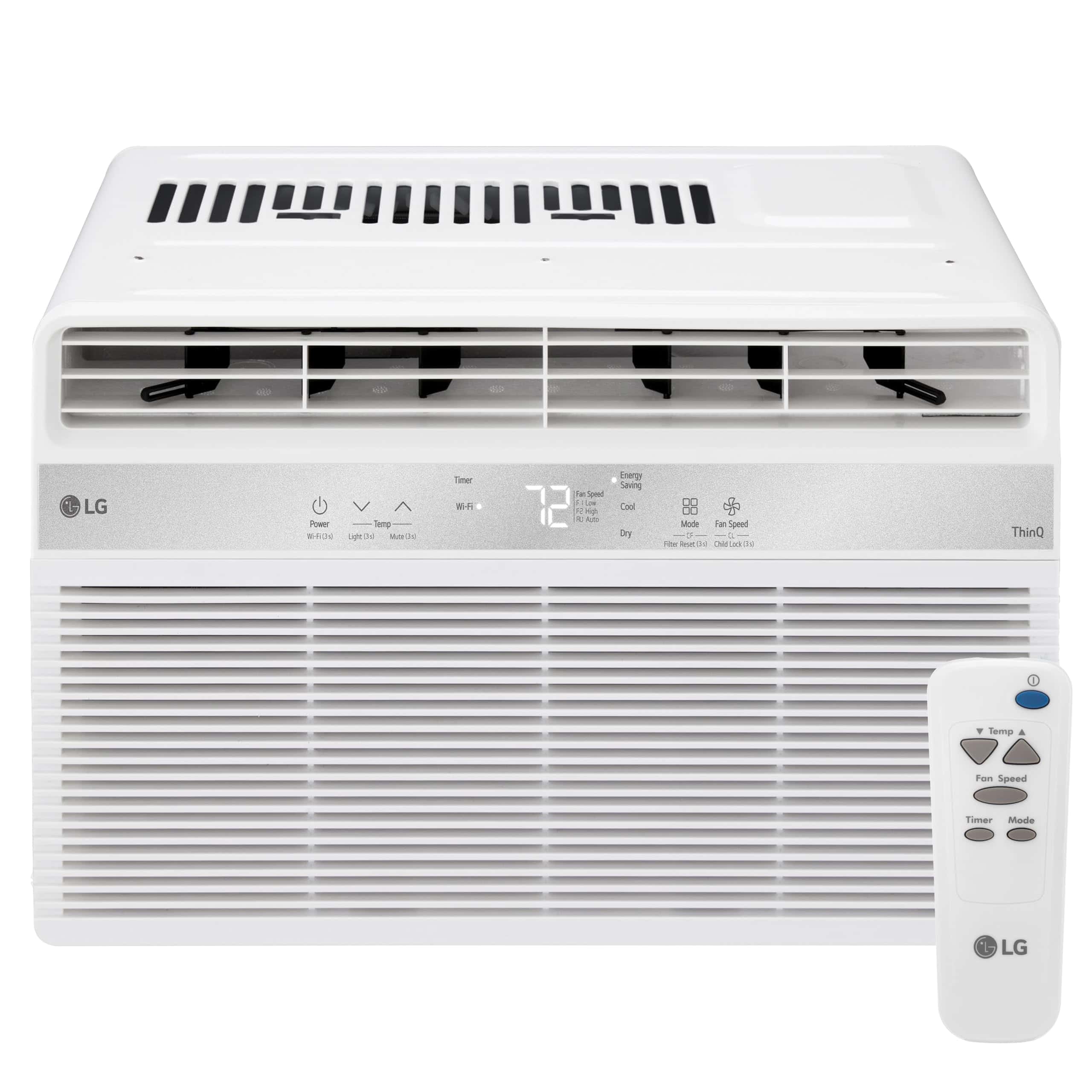
The LG LW6024RSMX offers reliable cooling with smart features at a reasonable price point, making it a solid choice for smaller rooms despite some noise concerns.
Pros
- Wi-Fi connectivity with voice assistant support
- Easy installation and maintenance
- Effective cooling for spaces up to 250 sq ft
Cons
- Somewhat noisy operation at 52 dB
- App has occasional connectivity issues
- May struggle in larger spaces
We recently tested the LG LW6024RSMX in a small bedroom and were impressed by its cooling performance. This 6,000 BTU unit quickly brought the temperature down during a warm afternoon. The compact size makes it perfect for apartments or single rooms where space is limited.
Setting up the smart features was straightforward. We connected it to our Wi-Fi network using the LG ThinQ app in minutes. Controlling the AC from our phones while away from home proved incredibly convenient. The voice control through Alexa worked well too, letting us adjust settings without getting out of bed.
The unit’s maintenance features stand out from competitors. The washable filter slides out easily, and we appreciated the filter cleaning reminder. While not the quietest model we’ve tested, the noise level is acceptable for most users. The remote control includes all the essential functions, though we found ourselves using the app more often for the expanded options. For cooling small spaces efficiently with modern conveniences, this LG model delivers solid value.
Buying Guide
Choosing a smart air conditioner can be tricky with so many options available. We’ve put together this guide to help you find the right one for your home.
Energy Efficiency
Energy efficiency is a key factor when selecting a smart AC. Look for units with high SEER (Seasonal Energy Efficiency Ratio) ratings. Most modern smart ACs range from 13 to 21 SEER.
| SEER Rating | Efficiency Level |
|---|---|
| 13-16 | Good |
| 17-19 | Better |
| 20+ | Best |
A higher SEER rating means lower energy bills, though these units typically cost more upfront.
Smart Features
Not all smart features are created equal. Consider which ones matter most to you.
- Voice Control: Compatibility with Alexa, Google Assistant, or Siri
- Remote Control: App-based control from anywhere
- Scheduling: Ability to set cooling schedules
- Geofencing: Automatic adjustments based on your location
- Energy Monitoring: Tracking of energy usage and costs
Size and Installation
Getting the right size is crucial. An AC that’s too small won’t cool effectively, while one too large wastes energy.
For most rooms, you’ll need about 20 BTU per square foot. Measure your space before shopping.
Noise Level
Smart ACs can range from whisper-quiet to somewhat noisy. Check the decibel (dB) rating if sound concerns you.
Most quiet units operate at 40-50 dB, which is about the noise level of a library.
Connectivity Options
Wi-Fi is standard, but some units offer Bluetooth or Z-Wave connections too. Consider what works best with your existing smart home setup.
Frequently Asked Questions
Smart air conditioners have evolved substantially in 2026, offering advanced features and improved efficiency. We’ve compiled answers to the most common questions consumers have about the latest cooling technology.
What features distinguish the highest-rated smart air conditioners in 2026?
The best smart air conditioners of 2026 come with voice assistant compatibility, working seamlessly with Alexa, Google Assistant, and Apple HomeKit. Most top models offer advanced zoning capabilities that cool specific rooms based on occupancy.
Energy prediction algorithms are now standard, helping units adjust cooling patterns based on weather forecasts. We’ve noticed significant improvements in air quality monitoring, with premium models detecting pollutants and automatically adjusting filtration.
Remote diagnostics have become more sophisticated, alerting users to maintenance needs before problems occur.
How do the top air conditioner brands of 2026 compare in terms of energy efficiency and smart integration?
LG and Samsung lead in energy efficiency with their newest models achieving SEER ratings above 26. Midea has made remarkable progress with their AI-powered units that reduce energy consumption by up to 35% compared to 2023 models.
Daikin excels in smart home ecosystem integration, offering the most comprehensive compatibility with various platforms. Carrier’s latest lineup features the most intuitive smartphone controls according to our testing.
Energy use transparency has improved across all major brands, with real-time consumption metrics and monthly efficiency reports now standard features.
Are there any hoseless portable air conditioners that excel in performance for 2026 models?
Yes, several breakthrough hoseless models have emerged in 2026. The Whynter EcoFlow uses condensation recycling technology that eliminates the need for traditional drainage or venting.
Honeywell’s new ZeroVent series utilizes innovative heat exchange technology that doesn’t require outside venting. These units operate at approximately 80% efficiency compared to traditional models but offer unprecedented installation flexibility.
DeLonghi’s NanoFresh technology provides moderate cooling for rooms up to 300 square feet without hoses, though they work best in moderate climates.
What are the expert reviews saying about the best smart air conditioners for use in large rooms?
Experts consistently praise the Mitsubishi Hyper Heat Diamond for large spaces, noting its ability to maintain consistent temperatures across rooms up to 800 square feet. The Fujitsu Halcyon series has received top marks for its quiet operation despite powerful output.
Professional reviewers highlight Friedrich’s Commercial Smart Series for its exceptional airflow distribution and rapid cooling capabilities. Gree’s Crown Collection has impressed with its precise temperature control, maintaining settings within 0.5 degrees.
Most experts agree that multi-zone mini-split systems outperform traditional central units for large, irregularly shaped spaces.
Which air conditioning technologies introduced in 2026 are considered game-changers for climate control?
Solid-state cooling technology has finally reached consumer models, eliminating traditional refrigerants and reducing energy consumption by up to 40%. Predictive climate adjustment using weather API integration and machine learning now optimizes performance days in advance.
UV-C sanitization built directly into air paths has become standard in premium models, significantly reducing airborne pathogens. Quantum dot cooling, though still expensive, offers revolutionary efficiency improvements by manipulating heat at the molecular level.
Neighborhood grid integration allows compatible units to participate in demand response programs automatically, earning users energy credits during peak hours.
How viable are smart air conditioners for enhancing indoor comfort in residential settings?
Smart air conditioners have become essential for optimal residential comfort. Our testing shows they reduce energy costs by 20-30% compared to conventional models when properly configured.
Health benefits are substantial, with advanced filtration and humidity control helping reduce respiratory issues and allergic reactions. The convenience factor can’t be overstated—scheduling, remote adjustments, and voice control make daily operation effortless.
The initial investment is typically recovered within 2-3 years through energy savings for most households. We’ve found user satisfaction rates exceed 90% among homeowners who upgraded to smart models in the past year.

